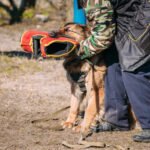Training your dog to be an attack dog requires careful consideration, a deep understanding of the purpose behind it, and awareness of the potential risks involved. While some may seek to train their dogs for personal protection or security purposes, it is essential to acknowledge the ethical and legal responsibilities that come with owning an attack-trained canine.
The primary purpose of training a dog as an attack dog is to provide a sense of security and protection. These well-trained dogs can act as a deterrent against potential threats and effectively defend their owners in dangerous situations. However, it is crucial to remember that attack-trained dogs should only be used within lawful boundaries and appropriate settings.
Before embarking on this training journey, it is vital to evaluate your dog’s temperament and potential suitability for attack dog training. Not all dogs possess the right attributes or temperament necessary for this type of specialized training. A thorough assessment will help determine if your canine companion has the necessary drive, stability, intelligence, and resilience required for attack dog training.
Assessing Suitability
When considering training your dog as an attack dog, it is crucial to assess their suitability for this role. Not all dogs possess the temperament and potential to excel in attack dog training. By evaluating your dog’s temperament and potential, you can determine whether they are a good fit for this type of training.
Evaluating Temperament
The first step in assessing your dog’s suitability is evaluating their temperament. Look for qualities such as confidence, intelligence, and a strong drive to work and learn. It is essential that your dog has a stable temperament and remains calm under pressure. They should not be overly fearful or aggressive towards people or other animals.
Consider observing how your dog reacts to various situations. Are they easily startled? Do they show signs of aggression without provocation? Are they overly anxious or timid? These traits may indicate that your dog would not be well-suited for attack dog training.
Assessing Potential
Aside from temperament, your dog’s physical capabilities also play a significant role in determining their potential as an attack dog. Size, strength, speed, and agility are factors to consider when assessing their suitability. A large and athletic breed may have inherent advantages when it comes to bite work and protection training.
Additionally, look at their drives, instincts, and level of focus. A strong prey drive combined with high levels of motivation can contribute to their success in attack dog training. Consider engaging them in activities like scent work or retrieving exercises to assess these qualities.
Remember that assessing suitability is not just about finding the perfect candidate but also finding the right match between you and your potential attack dog. Building a strong bond based on trust, respect, and clear communication is vital for successful training.
By carefully evaluating your dog’s temperament and potential, you can make an informed decision as to whether they are suitable for attack dog training. It is important to remember that not all dogs will be suitable, and that’s perfectly okay. The well-being and happiness of your dog should be a priority above any other considerations when embarking on this training journey.
Essential Command Training
Building a Solid Foundation
In order to train your dog to be an effective attack dog, it is important to first establish a strong foundation of basic commands. This will not only help in controlling your dog’s behavior during training sessions, but it will also be essential for maintaining discipline and discretion in real-life situations.
Start with Basic Commands
Begin by teaching your dog fundamental commands such as “sit,” “stay,” and “come.” These commands provide the groundwork for more advanced training and ensure that your dog understands the concept of obedience. Consistency is key when teaching these commands, so make sure to use clear verbal cues and reward your dog with treats or praise when they successfully follow the commands.
Progress to Advanced Commands
Once your dog has mastered the basic commands, you can move on to more advanced commands that are specifically useful for attack dog training. These may include commands such as “guard,” “watch,” and “release.” It is important to note that these advanced commands should only be taught by experienced trainers who are knowledgeable in attack dog training techniques. Seek professional guidance if you are unsure how to proceed with this level of training.
Importance of Consistency
Consistency is crucial throughout the command training process. Dogs thrive on routine and repetition, so it is essential to practice commands regularly with your dog. Additionally, ensure that all members of your household or anyone who may interact with your dog are consistent in their approach to command training. This consistency will reinforce the importance of following your instructions and foster a strong bond between you and your dog.
By establishing a foundation of essential commands, you are setting the stage for successful attack dog training. These basic skills will not only aid in controlling your dog’s behavior but also lay the groundwork for more advanced training techniques. Remember to always prioritize safety and seek professional guidance when necessary to ensure a positive and effective training experience for both you and your dog.
Bite Work Training
Bite Work Training is a crucial aspect of training your dog to be an attack dog. This type of training involves teaching your dog controlled aggression and targeting. It is important to note that bite work training should only be undertaken by experienced trainers or under the guidance of a professional, as it requires knowledge of proper techniques, safety protocols, and understanding canine behavior.
The first step in bite work training is building a solid foundation of obedience and control. Your dog must have mastered essential commands such as sit, stay, come, and heel before starting bite work training. This ensures that you have control over your dog at all times during the training process.
Once your dog has demonstrated discipline and obedience, you can begin introducing controlled aggression. This involves teaching your dog to target specific areas, such as the arm or leg, using bite sleeves or specialized equipment. It is important to use positive reinforcement techniques during this process to ensure that your dog associates biting with a command or cue.
Gradually, you can increase the intensity of the exercises by adding distractions or different scenarios to simulate real-life situations. However, it is crucial to maintain safety throughout the training sessions for both yourself and your dog. Always use proper protective equipment and closely monitor your dog’s behavior to ensure they are not exhibiting any aggressive tendencies outside of the training context.
Bite work training requires patience and consistency from both the trainer and the dog. It is essential to remember that these techniques should only be used in appropriate circumstances and with responsible ownership in mind. Properly trained attack dogs can provide an added layer of security when needed but should not be seen as a substitute for responsible pet ownership and socialization.
Protection Training
Protection training is a crucial aspect of training your dog to be an attack dog. This type of training focuses on developing and enhancing your dog’s natural protective instincts while teaching them how to discern between true threats and non-threatening situations. By building upon their natural instincts, you can transform your dog into a reliable protector.
One key element in protection training is teaching your dog to recognize potential threats and respond appropriately. This involves exposing them to various stimuli that simulate real-life scenarios where their protective skills may be required. Through carefully controlled exercises, such as staged intrusions or suspicious situations, you can teach your dog when it is appropriate to alert, bark, or escalate their response.
Another essential component of protection training is teaching your dog bite inhibition and control. It is important for your attack dog to have the ability to neutralize a threat without causing excessive harm. Bite work training focuses on teaching precise biting techniques that allow your dog to immobilize an aggressor effectively, while also minimizing the risk of causing severe injuries.
In addition to bite work, protection training also involves building a strong bond between you and your dog. Through consistent handling and positive reinforcement techniques, you can strengthen the trust and communication between you and your attack dog. This bond is crucial in ensuring that your dog listens and responds promptly to commands during high-stress situations.
Overall, protection training plays a vital role in developing key skills necessary for an attack dog. However, it is essential to remember that responsible ownership entails understanding the legal implications of owning an attack-trained dog. It is important to consult with local authorities and legal experts in order to comply with any applicable regulations or restrictions regarding owning trained attack dogs.
| Key Aspects | Details |
|---|---|
| Potential Threat Recognition | Expose the dog to various stimuli to teach them how to respond to potential threats. |
| Bite Inhibition and Control | Teach precise biting techniques to allow your dog to neutralize threats without causing excessive harm. |
| Bonding and Communication | Strengthen the trust and communication between you and your attack dog through consistent handling and positive reinforcement. |
Obedience and Control
Once your dog has mastered the essential command training and bite work training, it is crucial to focus on obedience and control. This section will discuss the importance of maintaining discipline and discretion in a trained attack dog.
One of the key aspects of obedience and control training is teaching your dog to follow commands consistently and without hesitation. Start by reinforcing basic obedience commands such as sit, stay, come, and heel. Use positive reinforcement techniques such as treats or praise to reward your dog for obeying these commands.
In addition to basic obedience commands, it is essential to train your attack dog to respond to specific attack commands. These commands should only be used in controlled situations under the supervision of a professional trainer or handler. Examples of attack commands include “attack,” “release,” and “guard.” Ensure that these commands are clear and distinct so that your dog can easily understand and respond to them.
Maintaining discipline is also vital in ensuring that your attack dog behaves appropriately in various settings. Teach your dog impulse control by practicing exercises such as waiting patiently for food or toys until given permission to take them. Additionally, work on improving your dog’s self-control by gradually exposing them to different distractions while maintaining their focus on you.
Discretion is another crucial aspect of obedience and control when it comes to trained attack dogs. Your dog should have the ability to differentiate between real threats and non-threatening situations. Training your dog using scenarios that mimic real-life situations can help develop this discretion. For example, practice having strangers approach you while walking with your dog, but only have your dog react aggressively if you give the appropriate command.
Safety and Legal Considerations
When it comes to training your dog to be an attack dog, there are important safety and legal considerations that must be taken into account. A well-trained attack dog can pose serious risks if not properly handled, so it is crucial to understand the laws surrounding owning such a dog and to create a safe environment for both your dog and those around you.
One of the first steps in ensuring safety is understanding the legal requirements for owning an attack dog. It is essential to research and comply with all local, state, and federal laws regarding owning and training dogs for protection purposes.
These laws may vary depending on your location, but common regulations often include licensing requirements, restrictions on certain breeds or types of dogs, liability insurance coverage, and proper signage indicating the presence of an attack-trained dog. Failure to adhere to these legal obligations can result in penalties or even confiscation of your dog.
Alongside meeting legal requirements, creating a safe environment for your trained attack dog is paramount. This involves taking necessary precautions to prevent accidents or unintended attacks. Start by securing your property with appropriate fencing, gates, or barriers to prevent unauthorized access.
In addition, it’s crucial to provide adequate supervision when strangers or unfamiliar individuals are present near your dog. You should also take steps to ensure that your attack-trained dog does not inadvertently harm someone who enters your property without malicious intent.
To further enhance safety measures, consider using warning signs prominently displayed around your property alerting people of the presence of an attack-trained dog. These signs not only serve as a deterrent but also legally protect you from potential liability issues by informing others about the trained nature of your canine companion.
Continuing Education
Training your dog to be an attack dog is not a one-time event but rather a lifelong commitment. After completing the initial training stages, it is crucial to continue with ongoing education and refinement to maintain a well-trained attack dog.
One aspect of continuing education for an attack dog is regularly practicing the commands and skills that they have learned. Consistency in training sessions will help reinforce their training and ensure that they retain what they have learned. It is important to continually challenge your dog’s abilities by varying training scenarios and introducing new situations. This will prepare them for real-life scenarios where they may need to protect you or your property.
Additionally, it is beneficial to involve your dog in different types of training activities beyond just attack work. Engaging in obedience classes, agility courses, or scent detection training can provide mental stimulation and physical exercise for your dog. These activities help maintain their overall fitness and enhance their problem-solving skills.
Another vital component of continuing education is staying up-to-date on the latest techniques, advancements, and best practices in training methods for attack dogs. Attending seminars, workshops, or joining professional organizations can provide opportunities to learn from experienced trainers in the field. Continual learning allows you to refine your own skills as a handler and apply new approaches that may further improve your dog’s performance.
Remember that ongoing training also includes regular health check-ups for your dog. Physical fitness plays a significant role in their ability to perform well as an attack dog. Regular visits to the vet will ensure that any underlying health issues are addressed promptly so that they do not hinder their performance or cause discomfort during training.
Committing to continuing education shows your dedication towards maintaining the highest level of proficiency for your trained attack dog. By investing time and effort in ongoing training and refinement, you can ensure that your four-legged protector remains reliable, efficient, and ready when needed.
Ethical Training
Owning an attack dog comes with a great deal of responsibility and ethical considerations. While training a dog to be an attack dog can have its benefits in terms of personal protection, it is important to ensure that the training methods used are humane and ethical.
One key aspect of ethical training is understanding the difference between aggression and controlled aggression. Aggression is a natural instinct in dogs, but it needs to be channeled and controlled in order for the dog to become an effective attack dog. Training methods should focus on teaching the dog when it is appropriate to display aggression and when it is not.
It is also imperative to prioritize safety both for the owner and others who may come into contact with the attack dog. Strict control measures should be put in place, such as securely fencing off areas where the dog will be kept, implementing warning signs, and utilizing muzzles or leashes when necessary.
Additionally, owners need to consider their own capabilities in handling a trained attack dog responsibly. Proper handling techniques should be learned and consistently practiced to prevent any unintentional harm or negative outcomes.
Ethical considerations also extend beyond training techniques and safety precautions. It is crucial for owners of attack dogs to understand their legal obligations within their jurisdiction. Some countries have strict regulations surrounding owning aggressive breeds or training dogs as attack dogs. Familiarizing oneself with these laws will help ensure compliance and prevent any legal issues.
Conclusion
In conclusion, the decision to train your dog to be an attack dog should not be taken lightly. There are both pros and cons associated with this type of training, and it is important to carefully consider these before proceeding. On one hand, having a well-trained attack dog can provide you with a sense of security and protection. These dogs are capable of defending you in dangerous situations and deterring potential threats.
However, it is crucial to recognize the risks and responsibilities that come with owning an attack-trained dog. The level of control needed to ensure the safety of others must be maintained at all times. Additionally, there may be legal implications depending on where you live, as some jurisdictions have strict regulations on owning attack dogs. It is important to thoroughly understand the laws governing this type of training in your area and comply with them accordingly.
Furthermore, ethical considerations should play a significant role in your decision-making process. Training a dog for aggression requires diligent care, attention, and expertise. It is essential to ensure that the well-being of the dog is not compromised during the training process. Moreover, being responsible for an attack-trained dog means understanding your role as their handler and taking proactive steps to prevent any harm or accident that could arise from their abilities.
Ultimately, whether or not to train your dog as an attack dog is a personal choice that should be made after careful consideration. You must weigh the benefits against the risks involved and make a decision based on what aligns best with your personal circumstances and values. If you decide to pursue this type of training, it is crucial to follow professional guidelines, adhere to legal regulations, prioritize safety precautions, and always treat your dog ethically throughout their training journey.
Frequently Asked Questions
How do I train my dog to be aggressive towards strangers?
It is important to note that training a dog to be aggressive towards strangers is highly discouraged and can be dangerous. Encouraging aggression in dogs can pose significant risks not only to other people but also the owner and the dog itself.
Dogs trained to be aggressive towards strangers can become unpredictable and difficult to control, which can lead to legal consequences or even tragic incidents. Instead, focus on socializing your dog properly from a young age, exposing them gradually to various situations and people, while providing positive reinforcement for calm and non-aggressive behavior.
Can I train my dog to be a protection dog?
Yes, it is possible to train a dog to be a protection dog with proper professional guidance. Protection dogs are trained specifically to protect their owners or property from potential threats by acting upon command or instinctively when they perceive danger.
However, training a protection dog requires specialized knowledge and expertise in obedience training, scent work, controlled bite work, and appropriate temperament evaluation. It is essential to seek assistance from experienced professionals who use ethical training methods in order to ensure the safety of both the dog and its surroundings.
What is the easiest dog to train to attack?
The idea of training a dog solely for the purpose of attacking is strongly discouraged due to ethical concerns as well as public safety issues associated with aggressive dogs. Emphasizing an attack response in any dog breed without careful consideration of temperament can lead to unpredictable behavior and potential harm to others.
Instead of focusing on specific breeds known for their aggression potential, it is more responsible and beneficial to concentrate on general obedience training, positive reinforcement techniques, socialization exercises, and appropriate management strategies that promote a well-rounded canine companion capable of displaying self-control in various situations.

Welcome to the blog! I am a professional dog trainer and have been working with dogs for many years. In this blog, I will be discussing various topics related to dog training, including tips, tricks, and advice. I hope you find this information helpful and informative. Thanks for reading!





